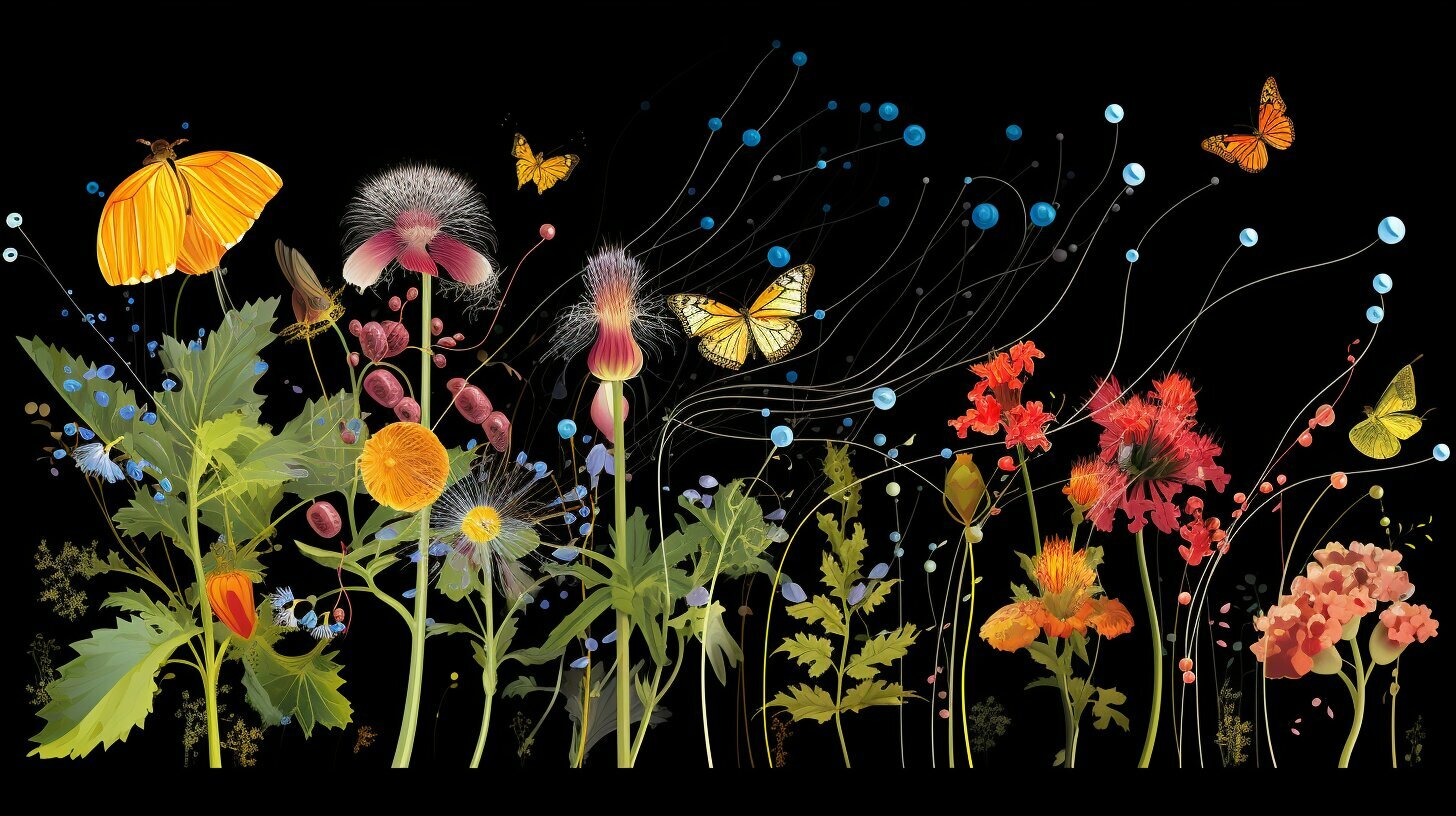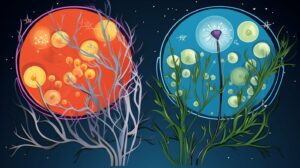Welcome to the fascinating world of botany! Have you ever wondered how plants are able to reproduce and perpetuate their species? In this section, we will delve into the intricate processes that allow plants to produce offspring and ensure their survival. From sexual reproduction to asexual reproduction, pollination, and fertilization, there is so much to explore!
Key Takeaways:
- Plants have evolved remarkable ways to ensure their survival and propagation
- Understanding how plants reproduce gives us a deeper appreciation for the incredible diversity and adaptability of the plant kingdom.
- The different methods by which plants reproduce include sexual reproduction, asexual reproduction, pollination, and fertilization.
- Each method of plant reproduction presents unique advantages and limitations.
- Get ready to unravel the mysteries of how plants reproduce and discover the intricate beauty of the plant kingdom!
Understanding Plant Life Cycle
Plants, like all living organisms, have a life cycle that allows them to reproduce and perpetuate their species. Understanding the life cycle of plants is essential to understanding plant reproduction. The plant life cycle can be roughly divided into two stages: the vegetative stage and the reproductive stage.
The vegetative stage refers to the period of growth and development that takes place before a plant reaches reproductive maturity. During this stage, the plant produces leaves, stems, and roots, and accumulates nutrients in preparation for reproduction. The length of the vegetative stage varies between plant species and can be influenced by environmental factors such as temperature and light.
The reproductive stage is when a plant reaches maturity and begins the process of reproduction. This stage is characterized by the production of flowers, fruits, and seeds. The reproductive process in plants can be either sexual or asexual, and in some cases, both.
Sexual reproduction in plants involves the fusion of male and female reproductive cells to form a zygote, which develops into a seed. The male reproductive cells are contained in the pollen, which is transferred to the female reproductive structure, or ovule, during pollination. The female reproductive cell, or egg, is located within the ovule and is fertilized by the male reproductive cell. This process results in the formation of a seed, which contains an embryo and a store of nutrients to help it grow into a new plant.
Asexual reproduction, on the other hand, does not involve the fusion of male and female reproductive cells. Instead, new plants are produced from vegetative structures such as stems, leaves, or roots. Asexual reproduction can occur naturally or can be induced by humans through methods such as cutting or grafting.
The plant life cycle is a complex and fascinating process that plays a vital role in the growth and propagation of plants. By understanding the life cycle of plants, you can better appreciate the diversity and adaptability of the plant kingdom.
The Role of Pollination
Now that you have a basic understanding of plant reproduction, let’s dive deeper into the important role of pollination. Pollination is the transfer of pollen from the male reproductive organ (anther) to the female reproductive organ (stigma) of a flower, resulting in the fertilization of the egg cell in the ovary and the formation of seeds.
Without pollination, many plants would not be able to reproduce and continue their species. Fortunately, there are different agents of pollination that facilitate the transfer of pollen including wind, water, and animals. Animal pollinators such as bees, butterflies, hummingbirds, and bats play a crucial role in plant reproduction by carrying pollen from flower to flower.
Interestingly, many plants have evolved to attract specific pollinators by using bright colors, unique shapes, and sweet fragrances. Some plants even offer rewards such as nectar to entice pollinators to visit their flowers.
The relationship between plants and pollinators is a fascinating one and is essential for the survival of many species. Unfortunately, some human activities such as pesticide use and habitat destruction have caused a decline in pollinator populations, which poses a threat to plant reproduction and biodiversity.
By understanding the importance of pollination, we can take steps to protect and conserve pollinator populations and ensure the continuation of plant reproduction for generations to come.
The Miracle of Fertilization
Plant reproduction involves the union of male and female reproductive cells, through a process called fertilization. This process brings together the genetic material from two parent plants, creating offspring that are genetically diverse.
The male reproductive cells, called pollen, are produced in the anthers of flowers. When a pollinator such as bees or butterflies visits a flower, they inadvertently pick up pollen grains from the anthers and transfer them to the stigma of another flower of the same species.
| Pollinators | Description |
|---|---|
| Bees | These flying insects collect nectar from flowers while also transferring pollen from one flower to another. |
| Butterflies | These insects are attracted to brightly colored flowers and have long tongues to reach into the nectar tubes. |
| Birds | Hummingbirds and other birds are attracted to brightly colored flowers with long, tubular shapes. |
Once the pollen grains land on the stigma, they begin to germinate and grow down the style, eventually reaching the ovary where fertilization occurs. The fertilized egg develops into a seed, and the ovary becomes the fruit that contains the seed.
Fertilization is a complex process that requires precise timing and coordination between the male and female reproductive cells. Interestingly, some plants have evolved unique reproductive strategies, such as self-fertilization or even the ability to change their sex depending on environmental conditions.
Overall, fertilization plays a critical role in plant reproduction, allowing for the production of seeds that will eventually lead to new generations of plants.
Asexual Reproduction in Plants
Did you know that not all plants rely on sexual reproduction? In fact, many plants have evolved specialized strategies for asexual reproduction, which allows them to produce offspring without the need for fertilization.
One common method of asexual reproduction is vegetative propagation, which involves the growth of new plants from specialized structures such as bulbs, corms, and tubers. Rhizomes, which are underground stems that produce new shoots and roots, are another example of asexual reproduction in plants.
Some plants also reproduce asexually through fragmentation, where a portion of the plant breaks off and grows into a new individual. This is often observed in mosses and ferns, which can spread rapidly through fragmentation.
One advantage of asexual reproduction is that it allows plants to produce offspring quickly and efficiently, without the need for a mate. This is especially useful for plants growing in harsh or unstable environments, where sexual reproduction may be difficult or impossible.
However, asexual reproduction also has limitations. Because offspring produced through asexual reproduction have the exact same genetic makeup as the parent plant, there is no genetic diversity. This can make a population vulnerable to disease or environmental changes that affect the entire population.
Overall, asexual reproduction in plants is a fascinating and resourceful strategy for ensuring survival and propagation. By understanding this process, we can gain a deeper appreciation for the remarkable ways in which plants have adapted to their environments.
Sexual Reproduction in Flowers
Flowers are not only beautiful to look at, but they also play an essential part in the reproductive process of many plants. With their bright colors and sweet fragrances, they attract the agents of pollination, such as bees, butterflies, and birds, which transport pollen from one flower to another.
The reproductive parts of a flower include the male stamen, which produces the pollen, and the female pistil, which contains the ovules. When a pollinator lands on a flower, it brushes against the stamen and picks up pollen, which it then carries to another flower, where it may deposit the pollen onto the stigma. The pollen travels down the style and fertilizes the ovules, resulting in the formation of seeds.
The intricate process of sexual reproduction in flowers has led to the evolution of a wide range of flower shapes, sizes, and colors, each adapted to attract specific pollinators. For example, some flowers, such as daisies and sunflowers, have a flat disc that provides a landing platform for bees, while others, such as orchids, have elaborate shapes that entice insects with their scent and nectar.
In addition to natural pollinators, humans have also played a role in flower reproduction through selective breeding, which has led to the development of new varieties of plants with desired traits, such as larger flowers, brighter colors, and longer bloom times.
Understanding the process of sexual reproduction in flowers allows us to appreciate the complex and intricate relationships between plants and their pollinators. It also enables us to make informed choices when selecting plants for our gardens, ensuring that we choose varieties that will thrive in our local environment and attract the pollinators that we want to encourage.
Plant Propagation: Bringing New Life
If you’re a gardening enthusiast, you know the joy of watching new plants grow. Did you know that you can create new plants from existing ones? This is called plant propagation, and it’s a fascinating aspect of plant reproduction that allows you to expand your garden without spending a lot of money. Here are some methods you can use:
| Method | Description |
|---|---|
| Cuttings | Take a cutting of a stem, remove the leaves from the lower part, and plant it in soil. Keep the soil moist and wait for roots to develop. |
| Division | Divide a clump of plants into smaller sections and replant them. This works well for perennials. |
| Grafting | Join a stem of one plant (the scion) to the root system of another (the rootstock). This method is used to propagate fruit trees and other plants. |
Plant propagation is a fun and rewarding way to experiment with different plants and create new combinations. It’s also a great way to preserve rare or unusual plants. By learning how to propagate plants, you can make your garden more diverse and interesting.
So go ahead and try your hand at plant propagation. You’ll be amazed at the results!
Conclusion
Congratulations! You’ve now unlocked the mystery of how plants reproduce. By understanding the complex and fascinating processes of plant reproduction, you can gain a deeper appreciation for the beauty and resourcefulness of the plant kingdom.
From the intricate stages of sexual reproduction to the varied strategies of asexual reproduction, you now have a comprehensive overview of the different methods by which plants propagate their species.
So, the next time you plant a seed, nurture a cutting, or admire a blooming flower, remember the incredible journey of reproduction that brought it into existence.
Happy Exploring!
FAQ
Q: How do plants reproduce?
A: Plants reproduce through various methods, including sexual reproduction and asexual reproduction. Sexual reproduction involves the union of male and female reproductive cells, while asexual reproduction allows plants to produce offspring without fertilization.
Q: What is the life cycle of a plant?
A: The life cycle of a plant involves different stages, starting from germination and culminating in seed production. It includes processes like growth, flowering, pollination, fertilization, and seed dispersal.
Q: What is the role of pollination in plant reproduction?
A: Pollination is the transfer of pollen from the male reproductive part of a plant to the female reproductive part, leading to fertilization. It plays a crucial role in plant reproduction by facilitating the transfer of genetic material and ensuring successful seed production.
Q: How does fertilization occur in plants?
A: Fertilization in plants occurs when the pollen from the male reproductive organ reaches the female reproductive organ and fuses with the female reproductive cells. This union leads to the formation of seeds, which contain the embryo of the next generation of plants.
Q: What is asexual reproduction in plants?
A: Asexual reproduction in plants refers to the ability of plants to produce offspring without the need for fertilization. It involves various methods like vegetative propagation, where new plants develop from vegetative parts such as stems, leaves, or roots.
Q: How does sexual reproduction occur in flowers?
A: Flowers are the reproductive structures of many plants, and sexual reproduction takes place within them. The different parts of a flower, including the stamen and pistil, play distinct roles in the process. Pollination, fertilization, and seed development occur within flowers.
Q: What is plant propagation?
A: Plant propagation is the process of creating new plants from existing ones. It involves methods like taking cuttings, dividing plants, or using specialized techniques such as grafting. Plant propagation allows for the multiplication of desirable plant varieties.
Q: Why is understanding plant reproduction important?
A: Understanding plant reproduction helps us appreciate the incredible diversity and adaptability of the plant kingdom. It also enables us to propagate plants, improve agricultural practices, and contribute to conservation efforts. Furthermore, it allows us to better care for and appreciate the plants around us.





Pingback: Unraveling the Mystery: Can Plants Get Cancer?
Pingback: Unveiling Nature's Mystery: Are Plants Alive?
Pingback: Are Plants Sentient? Unraveling Nature’s Mysteries